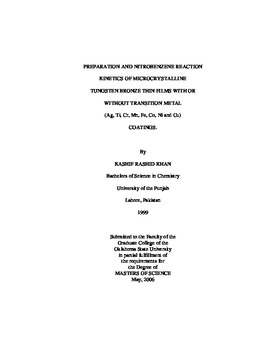| dc.contributor.advisor | Materer, Nicholas F. | |
| dc.contributor.author | Khan, Kashif Rashid | |
| dc.date.accessioned | 2014-03-14T21:53:37Z | |
| dc.date.available | 2014-03-14T21:53:37Z | |
| dc.date.issued | 2006-05-01 | |
| dc.identifier.uri | https://hdl.handle.net/11244/8085 | |
| dc.description.abstract | Microcrystalline tungsten bronze (HxWO3) thin films are prepared using wet chemical techniques from tungsten oxide thin films. The oxide films are obtained by thermal oxidation of a sputter deposited tungsten metal film on a quartz substrate. X-ray photoelectron and visible spectroscopy results confirm that these films are indistinguishable from conventionally prepared tungsten bronze powders. The use of a quartz support allows the total amount of incorporated hydrogen in the film to be quantified by monitoring the absorbance at 900 nm. Once formed, the reduction kinetics of nitrobenzene and the concomitant oxidation of the tungsten bronze film are studied by measuring the absorption of 900 nm light as a function of time. By measuring the reaction rates on tungsten bronze films of various thicknesses a lower bound of 2 x 10-13 cm2/sec is obtained for the hydrogen diffusion constant within the film. To increase the surface reaction rate, various transition metals (Ag, Ti, Cr, Mn, Fe, Co, Ni and Cu) are deposited on the surface using wet chemistry. By submerging tungsten bronze films in aqueous solutions of these transition metals, the bronze film will reduce the metal ions to form a metallic coating. For silver, deposition is controlled by submerging the films with different hydrogen concentrations in a silver nitrite solution and are quantified by the percent decrease in the absorbance of the films at 900 nm relative to the absorbance of freshly prepared bronze films. The fastest reduction rate of nitrobenzene is obtained from silver coating tungsten bronze films prepared from an uncoated bronze film whose absorbance at 900 nm has decayed to 75%-100% of its initial value. SEM and XPS studies of these films show that the even distribution of silver particles on the surface is responsible for the fast oxidation and reduction. In addition to silver, coated bonze films were prepared from the 1st row transition metals. In general, the reaction rate increases with atomic number toward a maximum around iron and then decreases. One exception to this general trend is the titanium coated bronze film. The reaction rate of these films exceeded that of all other transitions metals. | |
| dc.format | application/pdf | |
| dc.language | en_US | |
| dc.publisher | Oklahoma State University | |
| dc.rights | Copyright is held by the author who has granted the Oklahoma State University Library the non-exclusive right to share this material in its institutional repository. Contact Digital Library Services at lib-dls@okstate.edu or 405-744-9161 for the permission policy on the use, reproduction or distribution of this material. | |
| dc.title | Preparation and Nitrobenzene Reaction Kinetics of Microcrystalline Tungsten Bronze Thin Films with or Without Transition Metal (Ag, Ti, Cr, Mn, Fe, Co, Ni and Cu) Coatings | |
| dc.type | text | |
| dc.contributor.committeeMember | Benson, Stacy D. | |
| dc.contributor.committeeMember | Apblett, Allen W. | |
| osu.filename | Khan_okstate_0664M_1732.pdf | |
| osu.college | Arts and Sciences | |
| osu.accesstype | Open Access | |
| dc.description.department | Chemistry Department | |
| dc.type.genre | Thesis | |
| dc.subject.keywords | tungston | |
| dc.subject.keywords | tungston bronze | |
| dc.subject.keywords | thin films | |
| dc.subject.keywords | silver catalyzed thin films | |
| dc.subject.keywords | copper catalized thin films | |
